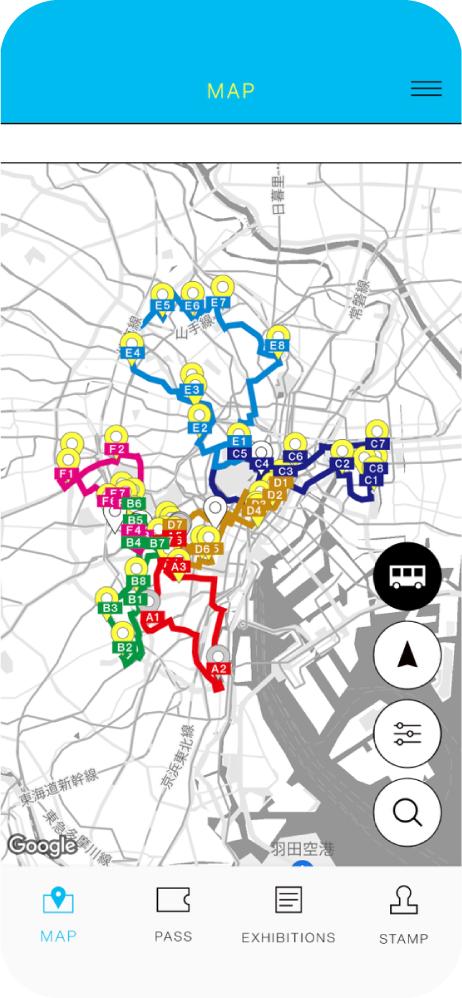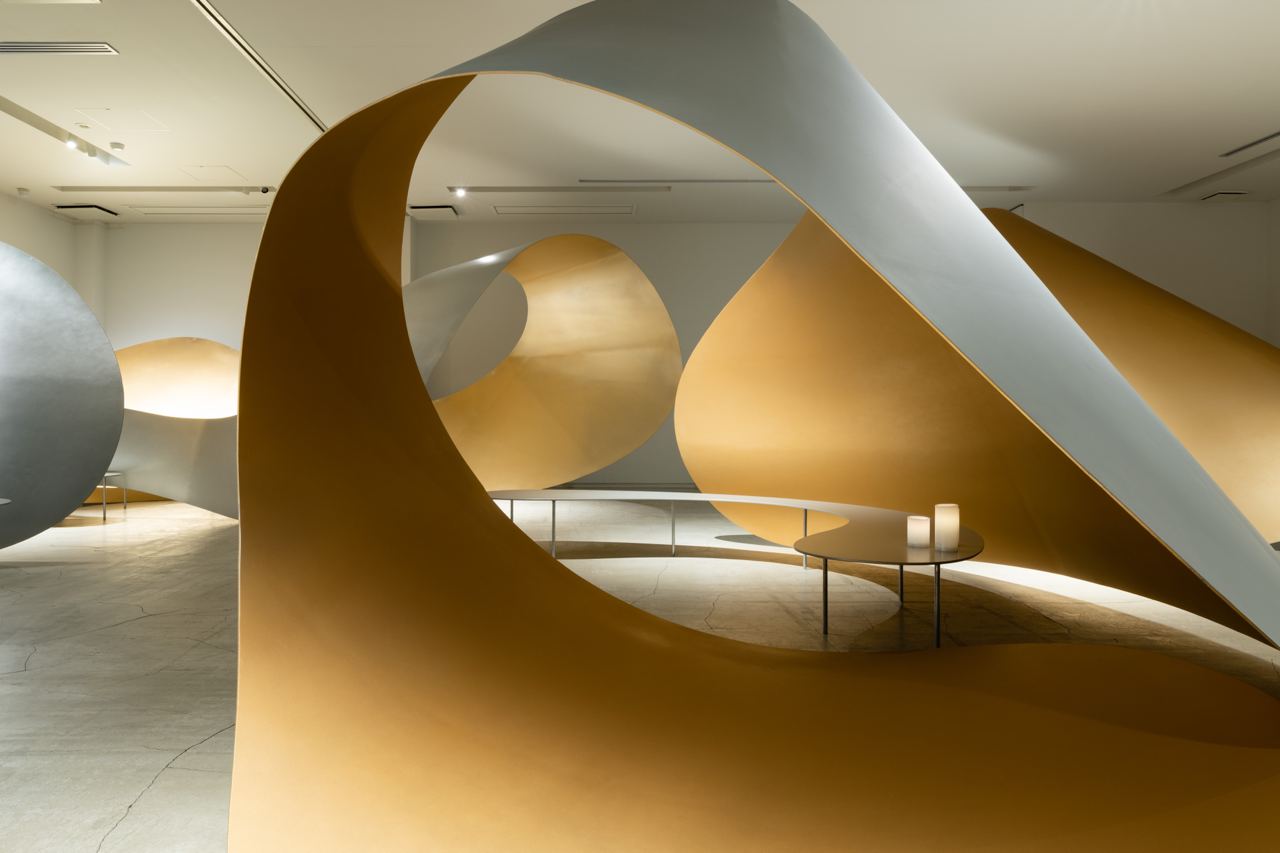Working, Crawling
Curated by Adam Szymczyk
Art Week Tokyo’s video program presents a selection of video works by Japanese and international artists. Curated by Adam Szymczyk, curator-at-large of the Stedelijk Museum, Amsterdam, and previously artistic director of documenta 14, the program is on view at SMBC East Tower in Marunouchi from November 2–6.
ART WEEK TOKYO VIDEO PROGRAM
“Working, Crawling”
Curated by Adam Szymczyk
Location: Earth Garden, SMBC East Tower 1F (AWT Bus Stop C4)
Hours: November 2–6, 10am–6pm,
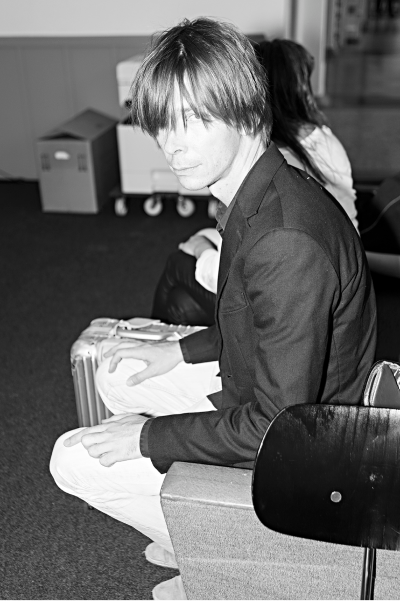
Statement
At first glance, working and crawling seem to be at odds. The former conventionally refers to skilled activity that leads to the achievement of a purpose defined at the outset or a new discovery, while the latter is a form of slow movement that is generally not respected in human societies, reserved for beings unjustly considered inferior. And yet artists have the capacity to unsettle the received order of things, subvert the hierarchies that order supports, and question the value systems behind it. Thus, crawling becomes a noble art, which exposes the static and repressive power structures that rule and regulate our everyday behavior in cities and elsewhere. Artists are slow workers and they do not move toward resolutions in quick and easy steps; they crawl forward while often looking back.
Video works by 13 Japanese and international artists were selected by the curator from among those submitted by galleries participating in Art Week Tokyo. In response to the pervading mood of reflection and questioning of received notions and learned behaviors in many of the works in this group, the curator has proposed a selection of five additional works that complements the program as its coda. The performances in those videos foreground crawling—or staying low—as a medium for demonstrating humility as a form of rebellion. The rhetorically exaggerated submissiveness inherent to the crawling or reposing body turns into a clear rejection of “normal” behavior that hides prejudice based on class, race, gender, and economic difference.
Adam Szymczyk
Adam Szymczyk (b. 1970 in Piotrków Trybunalski, Poland) is a curator and author based in Zurich. He is Curator-at-Large at the Stedelijk Museum in Amsterdam.
After cofounding the Foksal Gallery Foundation in Warsaw in 1997, Szymczyk worked as Director of Kunsthalle Basel from 2003 to 2014. In 2008, he cocurated with Elena Filipovic the 5th Berlin Biennale for Contemporary Art, “When Things Cast No Shadow.” In 2011, he received the Walter Hopps Award for Curatorial Achievement from the Menil Foundation in Houston. He served as Artistic Director of documenta 14 in Athens and Kassel from 2014 to 2017.
Szymczyk is a Member of the Board of the Museum of Modern Art in Warsaw, the Scientific Committee of MUDAM Luxembourg, and the Advisory Committee of Kontakt Collection in Vienna. From 2019 to 2021 he led the seminars Principle of Equality and Undoing Landscape at Akademie der bildenden Künste in Vienna. In 2022, he cofounded Verein by Association, a nonprofit cultural organization in Zurich.
Recent curated exhibitions and projects include “Yannis Tsarouchis: Dancing in Real Life” at Wrightwood 659 in Chicago (2021) “Other Voices, Other Rooms” at the Criminal Investigation Department of Zurich Municipal Police (2021), and “Life, Without Buildings” at gta Exhibitions, the gallery of the Institute of History and Theory of Architecture at the Swiss Federal Institute of Technology (ETH) in Zurich (2022).
Participating Artists
- Yu Araki
-
Yu Araki
Transcreation: YEDDO
2019
18′00″In Transcreation: YEDDO, Araki attempts to retrace French writer Pierre Loti’s (1850–1923) footsteps by revisiting the same locations Loti mentions in his travelogue Japoneries d’automne (1889). For this particular video series, Araki cites the 1953 Japanese edition (Kadokawa Shoten; translated by Kikuichiro Murakami and Kiyoshi Yoshihi) and employs unmodified extracts from the book as subtitles. Through the playful juxtaposition of contemporary Japanese imagery with a 130-year-old text on Tokyo as viewed through a Western gaze, Araki exposes scenes that are neither from the past nor present.About the Artist
Yu Araki (b. 1985) received his BFA in Sculpture from Washington University in St. Louis and earned his MA in Film and New Media Studies at Tokyo University of the Arts. As a failed English/Japanese interpreter, he frequently revisits themes of mistranslation and misunderstanding in intercultural contexts, through which he explores “difference” via reenactments, remakes, and reanimations. He has shown at MUJIN-TO Production, gallery αM, Pola Museum of Art, Shiseido Gallery, Yokohama Museum of Art, Art Sonje Center, FID Marseille, and the International Film Festival Rotterdam, among other Japanese and international venues. In 2018, he was a guest resident at Rijksakademie van beeldende kunsten in Amsterdam. Araki was selected as one the finalists for the Future Generation Art Prize 2019. In 2023, he will present a newly commissioned work at the Yebisu International Festival for Arts & Alternative Visions in Tokyo.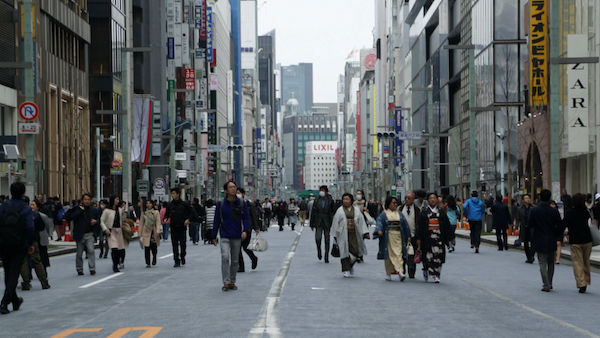
Yu Araki, Transcreation: YEDDO (2019) ©Yu Araki, Courtesy of the artist and MUJIN-TO Production
- Takuma Ishikawa
-
Takuma Ishikawa
Lessons and Conveyance
2016
5′48″The two-channel video work Lessons and Conveyance features three female characters in a dance lesson—an instructor, a demonstrator, and a spectator—whose gestures collectively convey a single “dance.” The video replays rapid shots taken by a digital camera (at three-to-four frames per second). Eschewing standard video editing processes, Ishikawa made this video by sequencing about a thousand pictures while individually adjusting the color, brightness, and display time (duration) settings of each. This imbues the imagery with a jerky rhythm, reminiscent of early silent films, which both makes the timeline between beginning and end ambiguous and enables viewers to discover new realities within the images. Through the body movements of dance, the disjointed continuities produced by the camera’s images give meaning to even the slightest act or gesture while also generating a heightened reality in which we can no longer distinguish which moves are conscious or not.About the Artist
Takuma Ishikawa (b. 1979–) works with not only the aesthetic aspects of photography and video, but also the social aspects of documentary practices. In doing so, Ishikawa creates works that explore the possibilities of photography as a unique artistic language that is situated between fiction and nonfiction, expression and documentation. Many of Ishikawa’s works, from photographs that recall the compositions of scenes from movies or classic paintings to one-frame videos made by sequencing scores of digital photographs, develop from the selection of a particular subject, setting, or situation.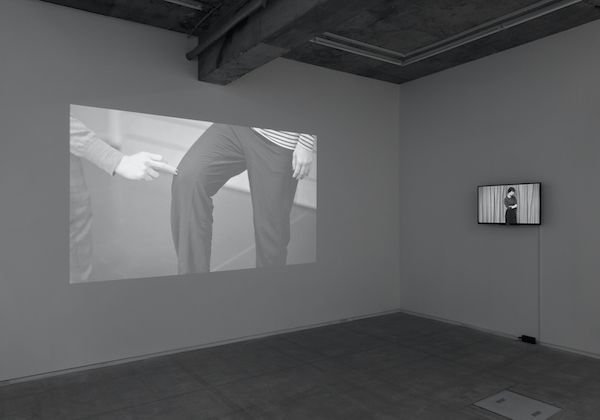
Takuma Ishikawa, Lessons and Conveyance (2016) “Lessons and Conveyance” Installation view at TALION GALLERY, 2016 Photo: Shizune Shiigi
- Maiko Jinushi
-
Maiko Jinushi
Lip Wrap / Air Hug / Energy Exchange
2020
2′00″Maiko Jinushi makes video works on the theme of how to relate to people. Around the time she produced Lip Wrap / Air Hug / Energy Exchange, she was thinking about changes in sexuality and the future state of sensuality, and composed the poem that appears in the video as a conceptual text for her work. “The video is based on a poem I wrote back in 2018. Utilizing elements of recital, drawing, and simple animation techniques, the work reflects the emotional states of people who feel reluctant to engage in direct physical contact yet desire intimate exchanges with others.”About the Artist
Maiko Jinushi (b. 1984) graduated with a degree in painting from Tama Art University. Through video, installation, and performance, she depicts how people relate to each other, using personal stories as a starting point. Recent solo exhibitions include “Brain Symphony” at Hospitale Project (Tottori, 2020), “The Sound of Desire” at HAGIWARA PROJECTS (Tokyo, 2018), “Silver Factories on 53rd Street” at Art Center Ongoing (Tokyo, 2018), and “A New Experience of Love” at HAGIWARA PROJECTS (Tokyo, 2016). Recent group exhibitions include New Artists Today Exhibition 2020: “Space of Rebirth” at Yokohama Civic Art Gallery (2020), “The Ecology of Expression: Remaking Our Relations with the World” at Arts Maebashi (2019), and he Yebisu International Festival for Art & Alternative Visions (Tokyo, 2019). In 2019–20 she was a resident at Jan van Eyck Academie, Maastricht, the Netherlands.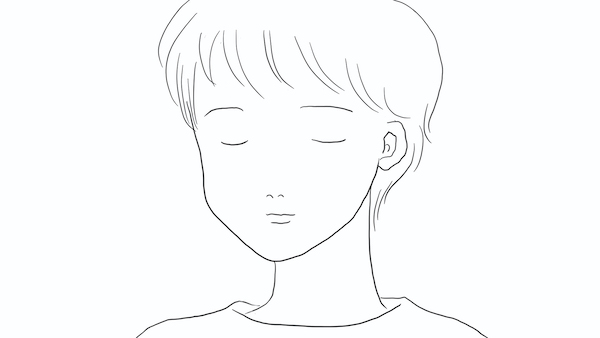
Maiko Jinushi, Lip Wrap / Air Hug / Energy Exchange (2020) ©Maiko Jinushi, Courtesy of HAGIWARA PROJECTS
- Naho Kawabe
-
Naho Kawabe
Breaking Memory
2016
7′52″Naho Kawabe uses charcoal to create large-scale installations that also address the social, historical, and cultural significance of her chosen material. She often employs inexpensive lace curtains as stencils for making charcoal patterns on the floor and/or glass panels. Such mass-produced industrial curtains adorned the windows of many homes in postwar Europe, when the coal industry was at its height. They were also common in Japan, where their prevalence also reflected an aspirational “longing for Europe.” Kawabe typically uses curtains with floral motifs to transform the charcoal/coal back into its original form of vegetal matter. In her video Breaking Memory, she uses the same technique as her installations to draw droplet patterns in charcoal on a French beach on the Atlantic Ocean. The patterns in the sand disappear with the rising of the tide.About the Artist
Naho Kawabe (b. 1976) is currently based between Germany and Japan. She graduated from Musashino Art University in 1999 and earned an MFA from the University of Fine Arts Hamburg in 2006. Kawabe works with diverse practices, including video and installations that combine multiple objects to address the theme of material transformation. Recent solo exhibitions include “Black and Green” at Tom Recihstein Contemporary (Hamburg, 2022) and “Blooming Black” at Boxes Art Museum (Guangdong, 2019). She has participated in numerous group exhibitions, including “Fuzzy Dark Spot” at Deichtorhallen Collection Falckenberg (Hamburg, 2019).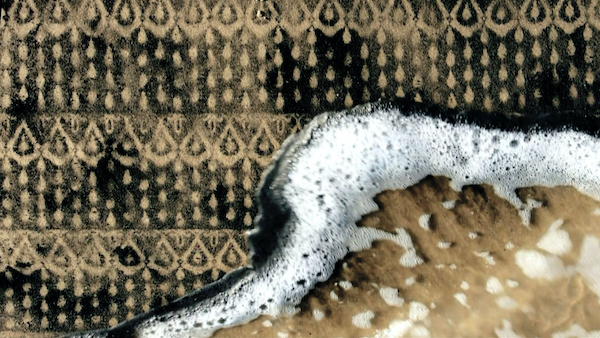
Naho Kawabe, Breaking Memory (2016) Courtesy of the artist and WAITINGROOM
- Sokchanlina Lim
-
Sokchanlina Lim
Letter to the Sea
2017
17′35″In Letter to the Sea, an underwater Sokchanlina Lim reads a letter addressed to the many deceased Cambodian fishermen who were forced into undocumented labor in Thai waters. First presented at the Singapore Biennale in 2019, the work is part of Lim’s ongoing project Cambodian Migrant Workers in Asia—A Conversation, in which the artist investigates the situations of Cambodian workers in Thailand, Malaysia, Singapore, China, Hong Kong, Japan, and South Korea, respectively. It was also recently on view in documenta fifteen, which ran from June to September of this year in Kassel, Germany.About the Artist
Employing practices spanning from photography and video to performance, Sokchanlina Lim uses his work to represent the shifts in culture, economy, politics, and ecology that are currently taking place in Cambodia and explore the issues these shifts bring about. Lim’s daily investigations show how quickly the landscape and society change under the influence of political agendas and economic trends that draw massive influxes of global capital into the country. Lim warns us of the uncertain future in store for local communities when culture and nature gradually fade away. His work has been shown at such major international exhibitions as documenta fifteen (2022), the Singapore Biennale (2019), the Bangkok Biennale (2018), and the Biennale of Sydney (2018), and has also been featured in exhibitions at institutions including the Mori Art Museum in Tokyo, the Fukuoka Asian Art Museum, and the Kaohsiung Museum of Fine Arts in Taiwan.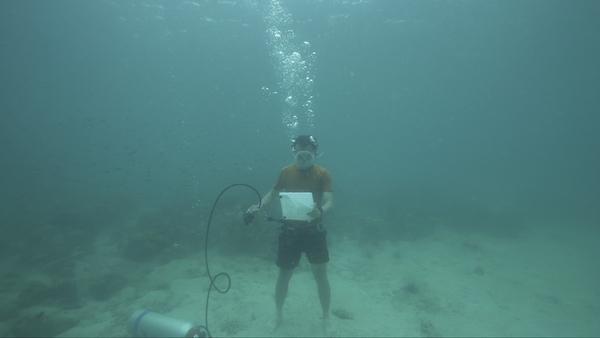
Sokchanlina Lim, Letter To The Sea | Thailand chapter, Cambodian Migrant Workers in Asia ‒ A Conversation (2019) Courtesy of the artist and nca | nichido contemporary art
- Tatsuo Majima
-
Tatsuo Majima
California
1997
3′00″In 2021, archaeologists announced they had made a discovery that confirmed Norse Vikings had settled in North America about 500 years prior to Columbus’s arrival, lending further support to a theory that was already widely held by researchers in the 1990s. Produced in 1997, California is based on the Viking settlement theory, which at the time lacked conclusive supporting evidence. In the video a costumed figure reminiscent of Mickey Mouse appears behind a Viking who has just landed on a beach and is proclaiming ownership of the land by shouting, “The land of my destiny. . . . destiny land!” Inspired by the hypothesis that the first Viking settlement may have been in what is now California, where the original Disneyland is located, Majima’s fantastice tale is prophetic in its warning that mass consumer society and the globalization of pop culture will bring about the supremacy of pleasure over historical consciousness, ideology, and even the tensions created by cross-cultural exchanges.About the Artist
Tatsuo Majima (b. 1970) lives and works in Shiga Prefecture. His recent major presentations include Aichi Triennale 2022; “A Mountain and a Crowd (Taikan and Leni) / Four Examinations (TPAM 2019 version)” at blanClass, Yokohama, in 2019; “Dance of the Day” at Taro Nasu, Tokyo, and “Identity XIV—Curated by Mizuki Endo—Horizon Effect” at nca, Tokyo, in 2018; the Okayama Art Summit and theItoshima Arts Farm in 2016; and the Oita Toilennale, PARASOPHIA: Kyoto International Festival of Contemporary Culture, and “Amerika: idea / fantasy / dream / myth / image” at Camberwell Space, London, in 2015.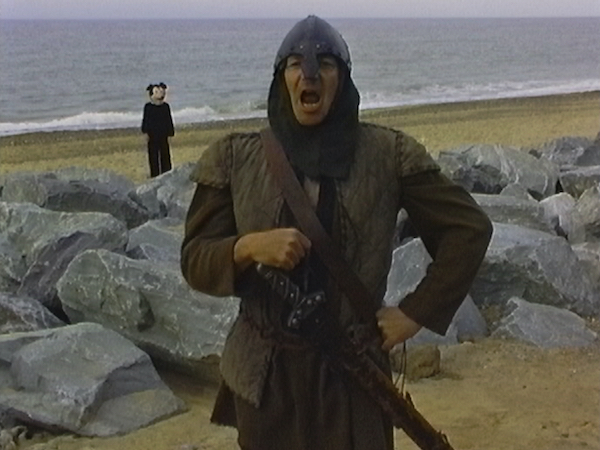
Tatsuo Majima, California (1993) ©Tatsuo Majima, Courtesy of TARO NASU
- Jun Nguyen-Hatsushiba
-
Jun Nguyen-Hatsushiba
Utsusu
2021
5′00″Utsusu captures everyday scenes from the artist’s home and backyard in Houston, using many frames of still images in sequence to present a survey of daily encounters. The work further ruminates on the idea of reincarnation by symbolically depicting the scenes as part of the cycle of life and death. Having made the decision to move to the United States after a successful art career in Vietnam, Nguyen-Hatsushiba now relives his late father’s legacy as an immigrant and an American parent, embodying his father in a transcendent state of past-life. The artist states that the work title, Utsusu, a Japanese word that variously means “to photograph,” “to duplicate,” “to transfer,” and “to project,” connotes the sense of transience he wanted to portray in the piece. The film reutilizes background music that the artist had previously composed and recorded for a different project It also incorporates scenes with contemporary dancers Masaru Kakio and Yukichi Matsumoto (the late director of the Osaka-based theater company Ishinha), who worked closely with Nguyen-Hatsushiba on past collaborations.About the Artist
Jun Nguyen-Hatsushiba was born in Tokyo in 1968 to a Vietnamese father and Japanese mother. After growing up and being educated between Japan and the United States, he earned his BFA from the School of Art Institute of Chicago in 1992 and then his MFA from Maryland Institute College of Art in 1994. He now works and lives in Houston. Ngyuen-Hatsushiba began his Memorial Project in 2001 with the goal of addressing such issues as boat people and social minorities and has since earned numerous international accolades for his work. He has exhibited in international biennial and triennial exhibitions including the Venice Biennale, the Istanbul Biennial, the Biennale of Sydney, and the Yokohama Triennale. His works are held in numerous museum collections, including the Centre Pompidou (Paris), the Guggenheim Museum (New York), Mori Art Museum (Tokyo), and the Whitney Museum of American Art (New York).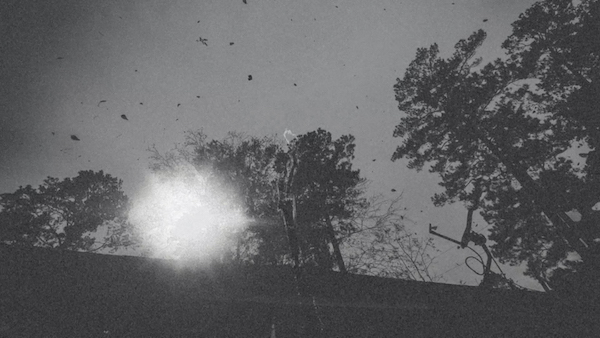
Jun Nguyen-Hatsushiba, Utsusu (2021) Courtesy of the artist and Mizuma Art Gallery
- Amapola Prada
-
Amapola Prada
Direction: North
2006
4′37″I search in the Lima map for a route that takes me to the north of the city. I choose to head from Avenida Alfonso Ugarte to Avenida Caquetá, a dangerous place in contrast to my lack of protection, a place where I can walk in the middle of two opposite directions, a route that leads me toward a symbolic north. The action takes place on February 10, 2006, at 8am during rush hour.
Statement
Lately and before, and before that, I never moved. It is necessary to stab me and open me like a gizzard to take out the shit that I have inside. To change skin; to pull me up by the hair to stand up; it is necessary that I bleed; that I face the city; that I go north; I do not need anything besides what I want to do. And nothing will stop me from doing what I want to do. You don’t listen to me, but I will be thinking that I have to do it and I won’t stop until I feel that nothing of what you are still stops me from doing what I want. You don’t listen to me, but I’m going to do it.About the Artist
Amapola Prada lives in Lima, Peru. The daughter of an actor and an actress, she started using her own body as a means of expression in her twenties. Prada never attended art school, instead studying Social Psychology at Pontifical Catholic University of Peru. Prada investigates the processes through which it is possible to express the emotional states, impulses, and latent tensions of an individual within a collective. Her primary source of information is the memories of bodies, which host in a symbolic and nonverbal way the sensory and subjective processing of everyday experiences.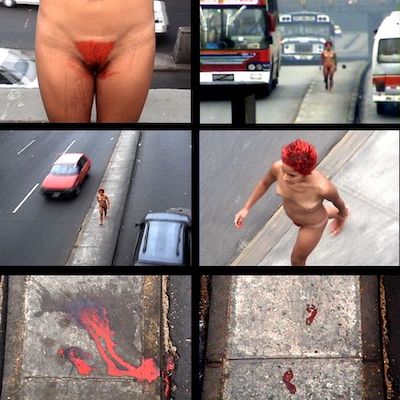
Amapola Prada, Direction: North (2006) ©Amapola Prada, Courtesy of KEN NAKAHASHI
Collage by Omar Lavalle
- Yuichiro Tamura
-
Yuichiro Tamura
Milky Mountain
2019
11′15″The boundaries between the real and unreal are blurred in Milky Mountain, which explores memories of the film shoot of The Last Samurai (2003) in New Plymouth, New Zealand, as recalled by Akihiko Karasawa, a Japanese extra in the film. Shot at the same locations as the film, Karasawa’s recollections are intercut with footage of the ghostly figure of a “Samurai General” riding on horseback down a deserted street late at night in New Plymouth. Tamura invites us to perceive the boundaries separating memory and fiction as porous and entirely permeable, and the past as something of a supernatural phenomenon akin to a Japanese kaidan tale, a story filled with ghosts and spirits that we summon momentarily through our remembering.About the Artist
Yuichiro Tamura (b. 1977) lives and works in Kyoto. Often produced on commission, Tamura’s works are based on existing images and objects and take an interdisciplinary approach to mediums including photography, video, installation, performance, and theater. Tamura creates multilayered narratives that mix fact and fiction by incorporating a wide range of sources, from indigenous historical themes to well-known popular subjects. He adds new interpretations and readings to original histories and memories, thereby transcending space and time and questioning what it means to be “contemporary.” In recent years he has also made works on museum collections.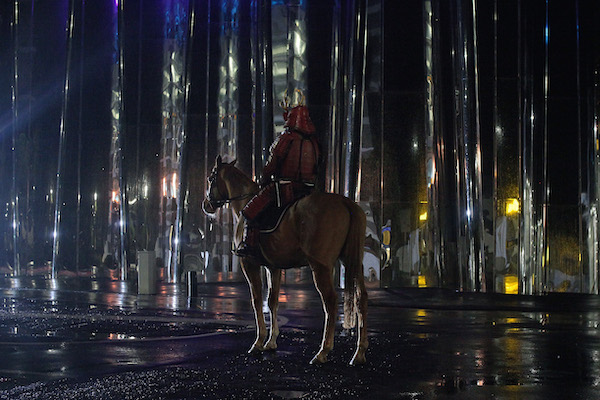
Yuichiro Tamura, Milky Mountain (2019)
- Evelyn Taocheng Wang
-
Evelyn Taocheng Wang
Schiermonnikoog (A Home Made Travel MV Series)
2015
8′04″From the moment Evelyn Taocheng Wang heard her friends’ stories about the existence of the Dutch Wadden Islands, mysterious and beautiful images of the islands formed in her mind. She wondered why only so few of the people she knew were visiting the islands when they were actually in such close proximity. From late autumn 2014 to early winter 2015 she visited each of the islands: from the easternmost island of Schiermonnikoog to the westernmost island of Texel. Spending a couple of days on each island, she recorded her experiences and encounters on the islands, filming the varying habitations, local architecture, and museums, while also enjoying the leisurely tourist routine. Evelyn’s travel report is no ordinary account, however. Similar to that of an eighties music video, Evelyn edits her experiences into a veritable travel-music video. In Schiermonnikoog, the artist translates and sings an old Taiwanese song in an eerily high pitched tone, while a local pop song sets a tone of summery lightness in Vlieland. As Evelyn explores the islands with childlike curiosity, the songs and their staccato subtitles offer up interpretations of both the islands’ moods and also, perhaps, stereotypical images of Dutch and/or Chinese tourists.About the Artist
Born in China in 1981, Evelyn Taocheng Wang currently lives and works in Rotterdam, the Netherlands. After studying art in China, she attended the Städelschule in Frankfurt, followed In 2012–14 by a residency at De Ateliers, Amsterdam. Wang’s practice encompasses paintings, performances, installations, and calligraphy, and addresses such broad themes as the appropriation of traditional Chinese painting, femininity, and cultural identity.
Wang’s works are held in the collections of institutions including the Art Institute of Chicago; Bonnefanten Museum, Maastricht; Centre Pompidou, Paris; and Museum Abteiberg, Mönchengladbach.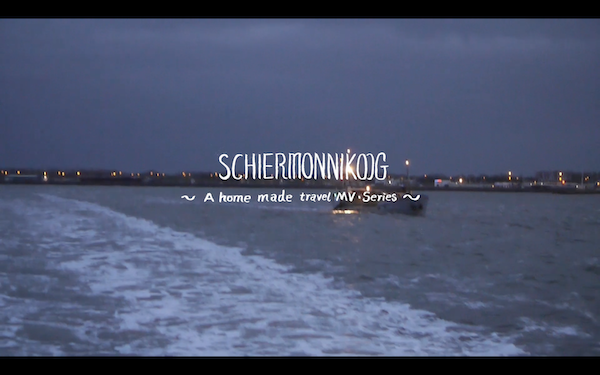
Evelyn Taocheng Wang, Schiermonnikoog (A Home Made Travel MV Series) (2015)
- Haruka Yamada
-
Haruka Yamada
Nocturne (Yokohama)
2020–22
16′13″Nocturne (Yokohama) is a video work comprising some 800 photographs, one for each step Yamada took during a walk through the titular city on a full moon night. When the movement of the moon, the silhouettes of the city’s buildings, and the artist’s gaze are combined into an image through the mechanism of the camera, it becomes possible, as if in some contemporary take on the ptolemaic system, to simultaneously gain a personal, romantic experience and a broader perspective that encompasses the correlations between humans and the various systems of celestial movement and urban space. This work, which constructs relationships between a celestial body, the city, and the artist by putting its own viewpoint in motion, is rich in suggestions for those of us living in complex societies.About the Artist
After graduating with a degree in oil painting from Musashino Art University, Haruka Yamada (b. 1986) studied space design and fine art at the École Nationale Supérieure d’Art et de Design in Dijon, France. Through her studies, she became interested in the practice of art in urban spaces. She is interested in how she can transform her own actions into artworks in a changing urban environment and reassess the relations between the city, nature, and people in relative terms. Yamada has participated in numerous exhibitions, including “Koganecho Bazaar 2020 Artists and Communities” (Yokohama, 2020), “Nocturne” at Poetic Scape (Tokyo, 2022), and Setouchi Triennale 2022. She is the winner of the Hiroshima City Museum of Contemporary Art’s Dokodemo Open Call 2016 and recipient of the Grand Prix of the Prix Dauphine pour l’art contemporain 2015.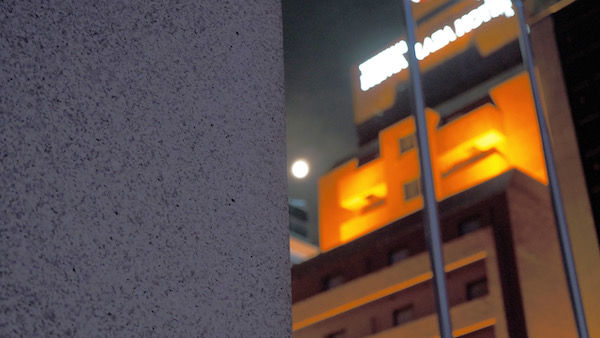
Haruka Yamada, Nocturne (Yokohama) (2020‒2022) ©Haruka Yamada, Courtesy of POETIC SCAPE
- Anri Yanase
-
Anri Yanase
KEIN LICHT. (No Light) —From the place where I am standing now
2016–2017
17′37″Austrian playwright Elfriede Jelinek’s play KEIN LICHT. (No Light) is inspired by the earthquake and tsunami that struck northeastern Japan on March 11, 2011, and the ensuing aftermath of the Fukushima Daiichi Nuclear Power Plant accident.
I wandered along a road in Takae in the north of Okinawa’s main island while reciting KEIN LICHT. (No Light) In doing so, I tried to gain an experiential understanding of the “we” that recurs throughout the play and think about who or what “we” are today. I also questioned where we are headed as we vacillate between I and we, direct and secondhand experiences, and the before and after (of, say, a disaster). I was inspired by the last line of KEIN LICHT. (No Light), “I want a verdict. I want your verdict!” I created this video work as my own response to Jelinek’s thought-provoking demand.
—Anri YanaseAbout the Artist
Anri Yanase (b. 1993) graduated from Kyoto University of Art and Design with a degree in Contemporary Art and Photography in 2016. She makes works as a way of thinking about and interpreting everyday events. Recent exhibitions include “New ways to grow: Artists envision a post-Covid world” at the University Art Museum, Tokyo University of the Arts (2021); “New Mutation #3: Kazuaki Kikuchi, Gaku Kurokawa, Anri Yanase” at Kyoto Art Center (2020); and “Heroes and People in the Japanese Contemporary Art” at Hyogo Prefectural Museum of Art (2019).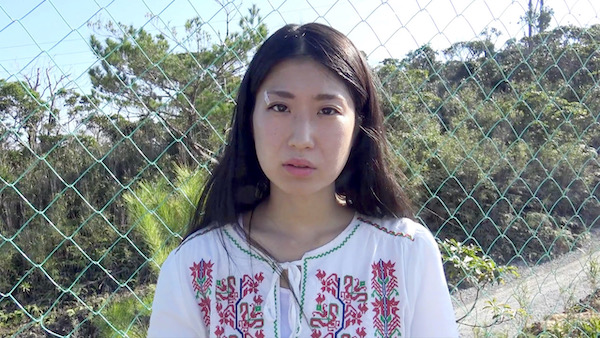
Anri Yanase, KEIN LICHT. (No Light) ―From the place where I am standing now. (2016‒2017) ©Anri Yanase
- Gozo Yoshimasu
-
Gozo Yoshimasu
Akutagawa Film 1: Kappa
2008
18′44″Akutagawa Film 1: Kappa (2008) is a video diary made in tribute to Ryunosuke Akutagawa, one of Japan’s preeminent literary figures of the Taisho (1912–1926) period. Immersed among the sounds of nature and daily life, Yoshimasu recites passages from Kappa, one of Akutagawa’s major works. The video was on view earlier this year in Yoshimasu’s solo exhibition at the Tabata Memorial Museum of Writers and Artists, Tokyo.About the Artist
Having first emerged as a member of the interdisciplinary avant-garde in 1960s Tokyo, Gozo Yoshimasu (b. 1939) combines poetry with performance, audio recordings, photography, and his own moving-image practice, gozoCine. Highlighting the multiplicity of language, his poems traverse diverse geographic and discursive topoi and test the limits of translation.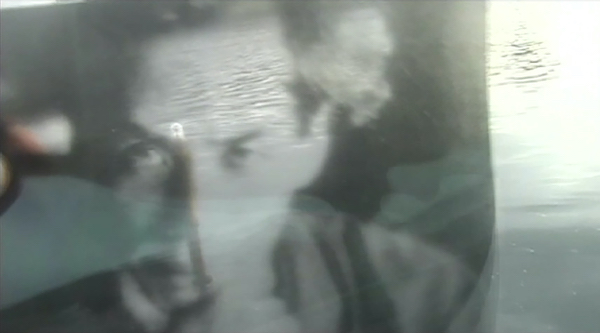
Gozo Yoshimasu, Akutagawa Film 1: Kappa (2008) ©Gozo Yoshimasu, Courtesy of Take Ninagawa, Tokyo
- Anna Janczyszyn-Jaros
-
Anna Janczyszyn-Jaros
W miasto (Into the City)
1993
22’00”
Collection of the Małopolska Museum of Contemporary Art FoundationThis video documentation of the performance Into the City is widely regarded as Anna Janczyszyn-Jaros’s most emblematic work. Created in 1993, around the time legal restrictions on abortion were adopted in Poland, the work comments on the change in the status of women in Polish public space. In the performance, the artist crawls along the streets of Kraków. The reactions of onlookers are vital to this film record (shot by Alicja Żebrowska). They display the whole spectrum of emotions, from indifference to aggression. As noted by Ewa Tatar, the artist crawls along the streets while complying with the traffic regulations—keeping to the right side, crossing intersections at green lights, and so on. But despite others’ attempts to bring her back to “the vertical,” she stubbornly returns to her horizontal position. The ending of the film is both symbolic and grotesque, as a woman with a baby carriage flees to avoid confronting the artist.About the Artist
Anna Janczyszyn-Jaros is a visual artist. She graduated with a degree in painting from the Kraków Academy of Fine Arts in 1991. In her work she combines numerous media, including performance, photography, installations, and interactive objects. Her works from the 1990s fall within the stream of critical art.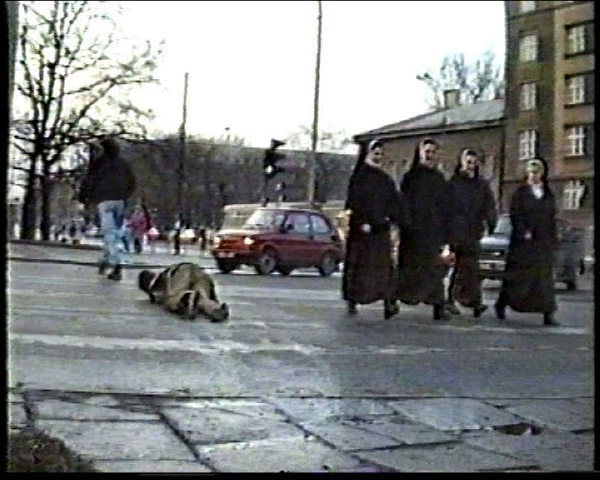
Anna Janczyszyn-Jaros, W miasto (Into the City) (1993) Courtesy of Małopolska Fundacja Muzeum Sztuki Współczesnej (Małopolska Foundation of the Museum of Contemporary Art), Kraków
- Pope.L
-
Pope.L
The Great White Way, 22 Miles, 5 Years, 1 Street (Segment #1: December 29, 2001)
2001-2006
6’35”“The black body is a lack worth having,” [Pope.L] told the interviewer shortly after he embarked on his most epic crawl, The Great White Way: 22 miles, 9 years, 1 street (2001–9).
In The Great White Way, Pope.L donned a party-store Superman outfit, replaced the superhero’s red cape with a red skateboard (with a yellow Superman shield at its center) strapped to his back and began to crawl in segments of about six city blocks at a time for the entire length of Broadway, New York City’s longest and most famous street, from its southernmost tip to its end in the South Bronx. The first installment of The Great White Way, from December 2001, began on Liberty Island and was documented in a six-and-a-half-minute video of the same title. The video opens with a shot of the American flag waving in the wind, followed by a close-up of the Statue of Liberty’s face. The camera then pans down the height of the statue, and reveals Pope.L already in the process of crawling. . . . [A]s he inches toward the water’s edge, two National Guard troopers confront him and his cameraman. One of them orders Pope.L to immediately stop what he is doing and “get back to the boat.”
Being the “Friendliest Black Artist in America,” Pope.L crawls to board the ferry. . . . In this process, a police semantics is revealed, one that articulates that even with a permit, even with proper paperwork, on Liberty Island a black man cannot and will not perform an “aberrant movement,” to use David Lapoujade’s expression. On Liberty Island, no juxtaposition of black destitution and black plenitude, no paradoxical, counterindexical, “anarchoreographic” black movement is to be allowed.
—André Lepecki, “Making Way,” in member: Pope.L, 1978–2001, ed. Stuart Comer with Danielle Jackson, exh. cat. (New York: Museum of Modern Art, 2019)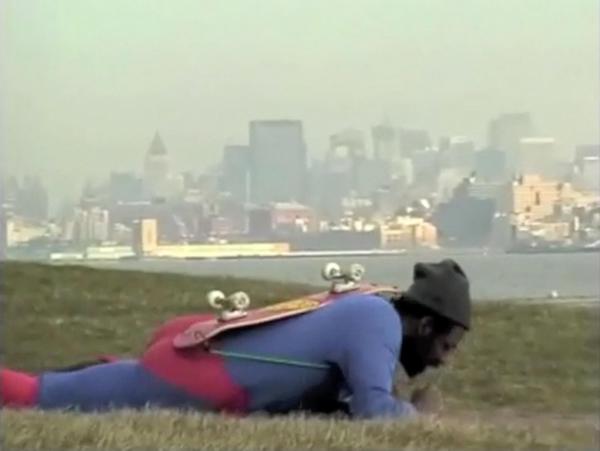
Pope.L, The Great White Way, 22 Miles, 5 Years, 1 Street (Segment #1: December 29, 2001) (2001) ©Pope.L, Courtesy of the artist and Mitchell-Innes & Nash, New York Shopping Crawl
2001
4’18”In 2001 Pope.L visited Japan on a six-month residency for the US–Japan Creative Artists Program. During his stay he staged a series of three performances in public and private spaces to interrogate and challenge attitudes toward homelessness and other forms of stereotyping in Japan. Working with local collaborators Ayako and Kyoko Kikuchi, he carried out Shopping Crawl on March 17, 2001, in Yoyogi Park, one of Tokyo’s most popular and symbolic recreational spaces, formerly a Japanese army parade ground and, subsequent to that, site of the US Air Force’s Washington Heights barracks before being converted into the main Olympic village for the 1964 Summer Olympics. An embodiment of focused concentration and physical endurance, Pope.L’s performance also touches upon the at-times troubled interactions between Japanese and African American cultures.About the Artist
Pope.L is a visual artist and educator whose multidisciplinary practice uses binaries, contraries, and preconceived notions embedded within contemporary culture to create artworks in various formats, from writing, to painting, performance, installation, video, and sculpture. Building upon his long history of enacting arduous, provocative, absurdist performances and interventions in public spaces, Pope.L applies some of the same social, formal, and performative strategies to his interests in language, system, gender, race, and community. The goals for his work are several: joy, money, and uncertainty—not necessarily in that order.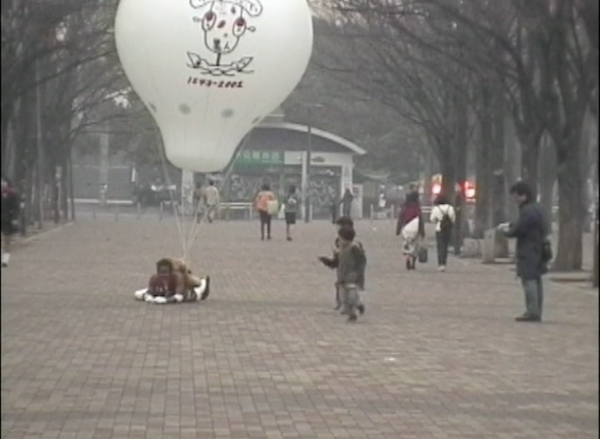
Pope.L, Shopping Crawl (2001) ©Pope.L, Courtesy of the artist and Mitchell-Innes & Nash, New York
- Georgia Sagri
-
Georgia Sagri
The New Kind
2003
HD video with sound
24’42”
Courtesy of the artist ©Georgia SagriThe New Kind documents the artist’s struggle to move across the pavement as she crawls through city streets by only making use of her lower body, with hands and feet bound. The video moves through the center of Athens from the meat market to Omonia Square. Born, raised, and still partly based in Athens, Georgia Sagri conducted this work in 2003 during an outburst of urban development in anticipation of the 2004 Summer Olympics, which reflected the changed subjectivities of the local populace. The artist has said of the city, “Every time you go out for a walk it is a protest.”About the Artist
Georgia Sagri (b. 1979) lives and works between Athens and New York. She is the founder of the semipublic art space ΥΛΗ[matter]HYLE (hyle.gr) and a tenured Professor of Performance at the Athens School of Fine Arts. At the center of her practice lies an exploration of performance as an ever-evolving field within social and visual life. Much of her work is influenced by her ongoing engagement in political movements and struggles regarding issues of autonomy, empowerment, and self-organization. Her first monograph was published by Sternberg Press in 2018 following her solo exhibitions “Georgia Sagri Georgia Sagri” at Kunstverein Braunschweig and “Georgia Sagri and I” at Portikus Frankfurt. Her book Stage of Recovery was published by Divided Publishing in May 2021.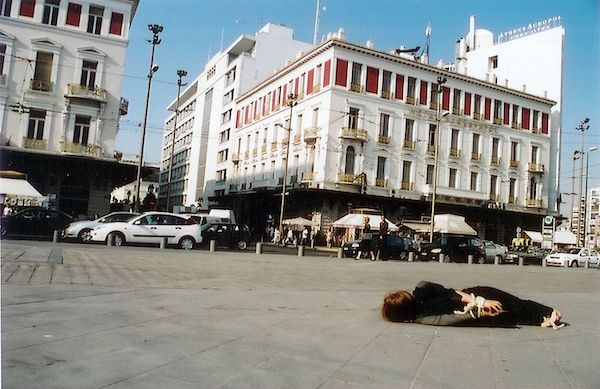
Georgia Sagri, New Kind (2003) ©Georgia Sagri, Courtesy of the artist
- Li Liao
-
Li Liao
Single Bed 01 (Optics Valley)
2011
24′ 02”
Courtesy the artist and WHITE SPACEIn a public space, Li Liao cleans up a single bed–sized area on the ground where he sleeps until he awakes either on his own or due to some interruption. He has carried out this performance four times: on an intersection on Guanggu Pedestrian Street in Wuhan, China; inside an ATM booth; beside a lake; and in a small playground.About the Artist
Li Liao (b. 1982, Hubei Province, China) currently lives and works in Shenzhen, China. He received his BFA in Oil Painting at Hubei Institute of Fine Arts in 2005. Creating semifictional autobiographical works based on daily life, Li presents a series of real life situations mixed with artistic actions. Through his often allegorical and self-deprecating actions, he takes the initiative to set up or take advantage of a situation to reveal his concern for the real problems that plague society, applying a strategy of “communal participation” to practicing what he preaches in micro-level social systems and under concrete circumstances. In this process, he also observes and questions the evaluation mechanisms and rules for family production, social production, and artistic production and attempts to provide a set of playful strategies to deal with stress, thus evoking a rethinking of experience.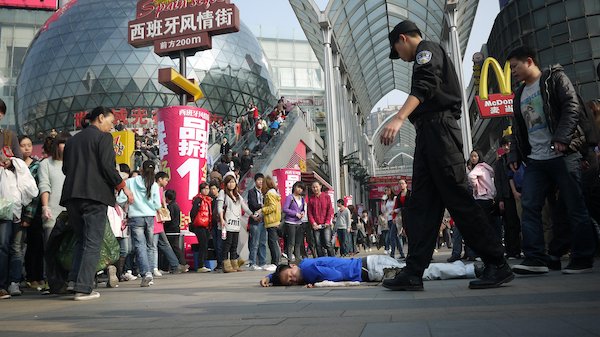
Li Liao, Single Bed 01 (Optics Valley) (2011) Courtesy of the artist and WHITE SPAC




